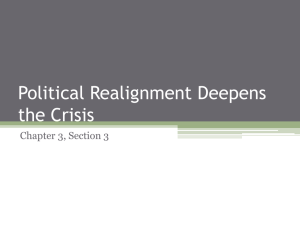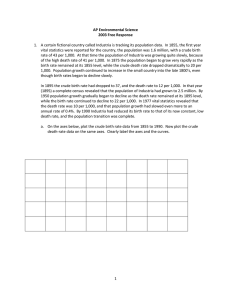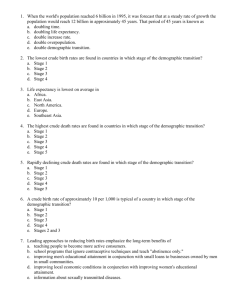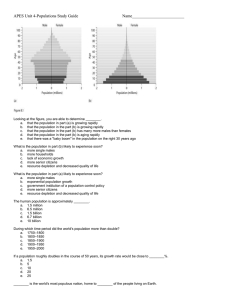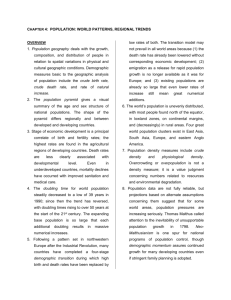Demographic Facts of Life
advertisement
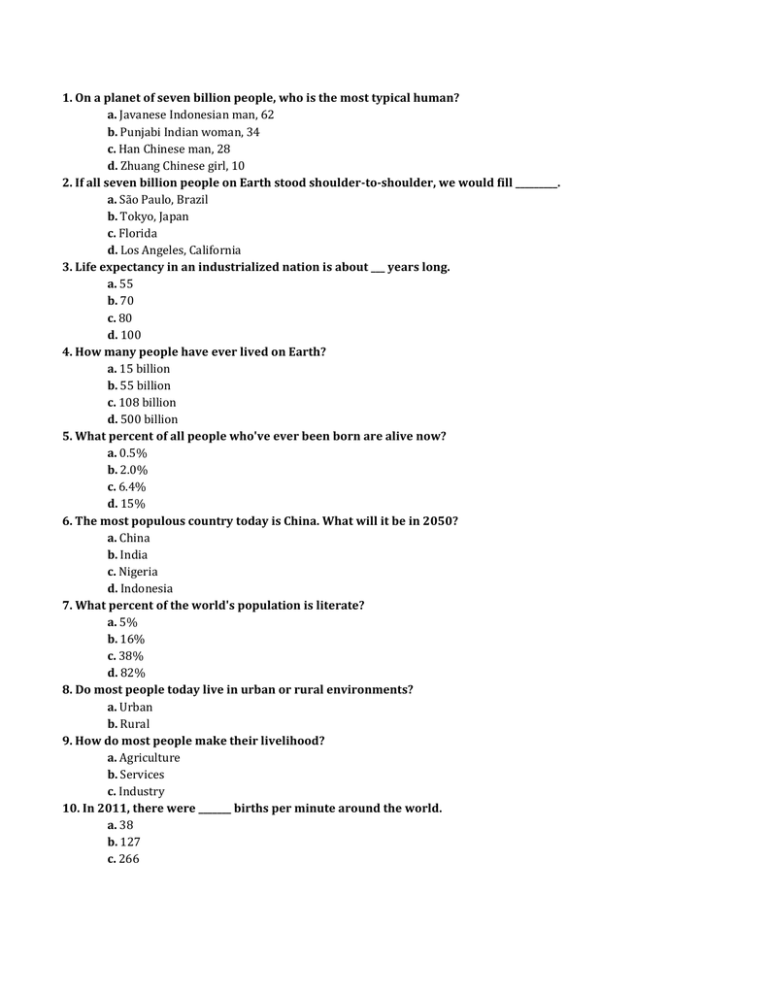
1. On a planet of seven billion people, who is the most typical human? a. Javanese Indonesian man, 62 b. Punjabi Indian woman, 34 c. Han Chinese man, 28 d. Zhuang Chinese girl, 10 2. If all seven billion people on Earth stood shoulder-to-shoulder, we would fill _________. a. São Paulo, Brazil b. Tokyo, Japan c. Florida d. Los Angeles, California 3. Life expectancy in an industrialized nation is about ___ years long. a. 55 b. 70 c. 80 d. 100 4. How many people have ever lived on Earth? a. 15 billion b. 55 billion c. 108 billion d. 500 billion 5. What percent of all people who've ever been born are alive now? a. 0.5% b. 2.0% c. 6.4% d. 15% 6. The most populous country today is China. What will it be in 2050? a. China b. India c. Nigeria d. Indonesia 7. What percent of the world's population is literate? a. 5% b. 16% c. 38% d. 82% 8. Do most people today live in urban or rural environments? a. Urban b. Rural 9. How do most people make their livelihood? a. Agriculture b. Services c. Industry 10. In 2011, there were _______ births per minute around the world. a. 38 b. 127 c. 266 AP ENVIRONMENTAL SCIENCE Name: ________________________________ DEMOGRAPHIC FACTS OF LIFE ACTIVITY AND THE RULE OF 70 PART I: Doubling Time Birth and death rates determine the rate of population growth. If the birth and death rates are similar, a population experiences little or no growth. When the birth rate far exceeds the death rate, the population soars. These rates are expressed as the number of births or deaths for every 1,000 people in a given year. For instance, in 1998 the world's birth rate was 23 per 1,000 and the death rate was 9 per 1,000. How would we determine the world's annual growth rate as a percentage? Calculate the world’s annual growth rate (percent) using the information above: The number of years it will take the population to double if the growth rate remains constant is easy to estimate using something called the Rule of 70. Doubling time (in years) = 70/rate of increase (in percent). Use the information above to calculate the number of years it should take for the population to double. PROCEDURE: Fill in Student Worksheet 1 and answer the following questions below. AP ENVIRONMENTAL SCIENCE DEMOGRAPHIC FACTS OF LIFE ACTIVITY AND THE RULE OF 70 STUDENT WORKSHEET #2 1. In 2010, the population of Upper Fremont is 200,000 and growing at a rate of 2% each year. a. If the rate of population growth remains constant, calculate the population in 2045. b. If the rate of population growth remains constant, calculate the population of 2080. 2. The population of Lower Fremont was 20,000 in 1968. In 2010 the population is 160,000. Assuming that the growth is exponential, calculate the average annual percentage rate of population growth in Lower Fremont since 1968. 3. In 2010, the crude birth rate in East Fremont was 25 and the crude death rate was 11. Calculate the percentage growth rate of East Fremont in 2010. If the population was 15,000 in 2010, and the population growth rate remains constant, when will the population reach 30,000? AP ENVIRONMENTAL SCIENCE DEMOGRAPHIC FACTS OF LIFE ACTIVITY AND THE RULE OF 70 4) A certain fictional country called Industria is tracking its population data. In 1855, the first year vital statistics were reported for the country, the population was 1.6 million, with a crude birth rate of 43 per 1,000. At that time the population of Industria was growing quite slowly, because of the high death rate of 41 per 1,000. In 1875 the population began to grow very rapidly as the birth rate remained at its 1855 level, while the crude death rate dropped dramatically to 20 per 1,000. Population growth continued to increase in the small country into the late 1800’s, even though birth rates began to decline slowly. In 1895 the crude birth rate had dropped to 37, and the death rate to 12 per 1,000. In that year (1895) a complete census revealed that the population of Industria had grown to 2.5 million. By 1950 population growth gradually began to decline as the death rate remained at its 1895 level, while the birth rate continued to decline to 22 per 1,000. In 1977 vital statistics revealed that the death rate was 10 per 1,000, and that population growth had slowed even more to an annual rate of 0.4%. By 1990 Industria had reduced its birth rate to that of its now constant, low death rate, and the population transition was complete. a) On the axes below, plot the crude birth-rate data from 1855-1990. Now plot the crude death rate on the same axes. Clearly label the axes and the curves. AP ENVIRONMENTAL SCIENCE DEMOGRAPHIC FACTS OF LIFE ACTIVITY AND THE RULE OF 70 DISCUSSION: 1) Why do you think some countries are doubling much more rapidly than others? Why do you think some countries, such as Italy, have reached zero population growth? 2) Which figures differ most greatly between countries, the birth rates or the death rates? How would you explain the wide disparity in birth rates among different countries? Why are death rates relatively low in many countries with high birth rates? 3) If you were a national leader in Kenya or Iraq, would you be concerned about the rapid population growth? Why or why not? Similarly, if you were national leader in Italy, would you be concerned that your country has reached zpg? Why or why not? 4) The population of the U.S. is actually growing at the rate of about 1 percent each year, more than its rate of natural increase. Where is the additional population growth coming from? Use this space for showing extra work:

